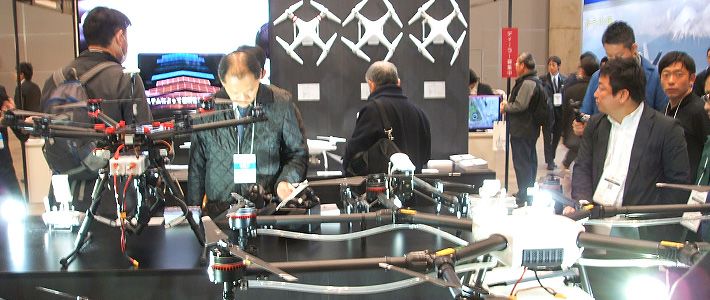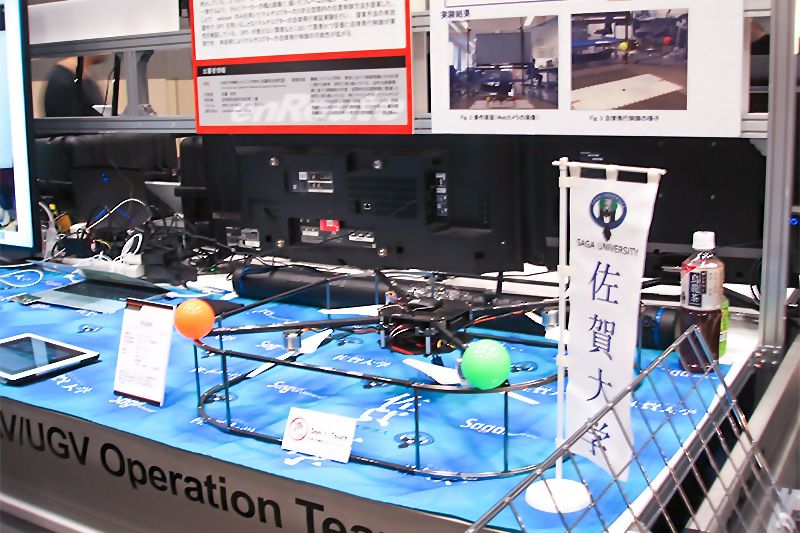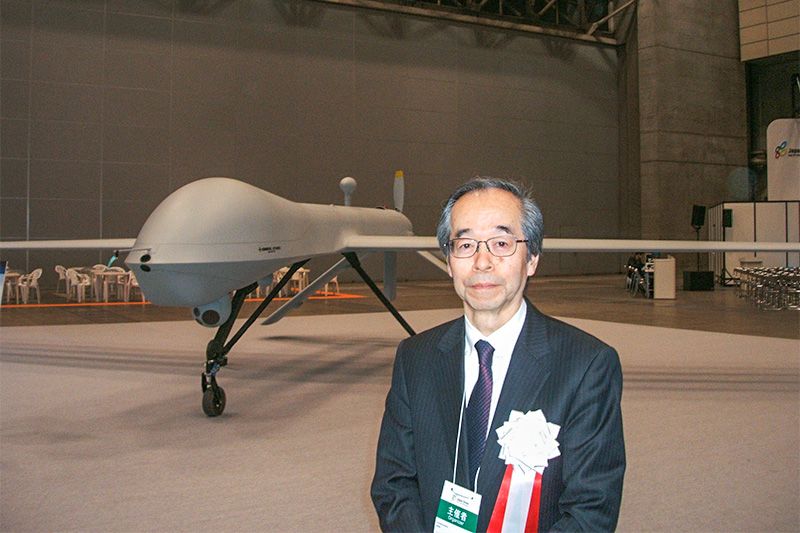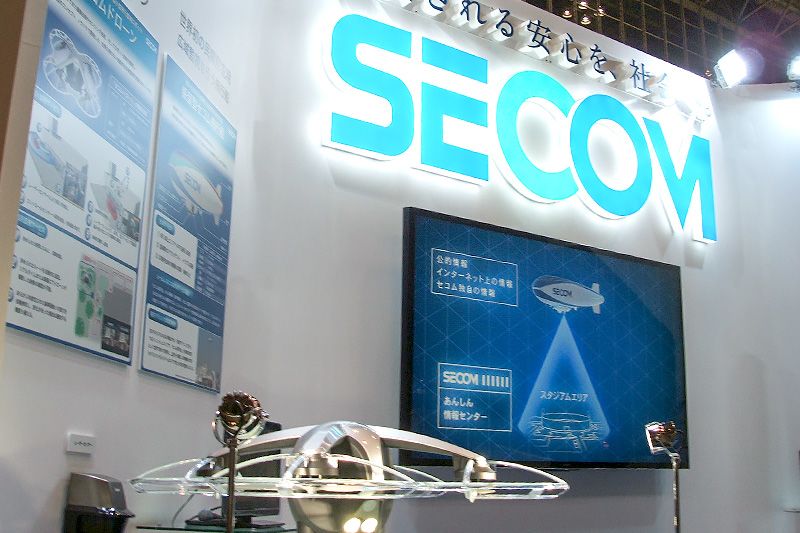
Year of the Drone
Economy Society- English
- 日本語
- 简体字
- 繁體字
- Français
- Español
- العربية
- Русский
A horde of flying robots converged on the city of Chiba this spring. Some had tiny cameras mounted on the front or underside, while others displayed spacious compartments designed to hold cargo. Though they revealed a surprising variety of designs, almost all were fitted with three or more propellers, allowing them to flit about and hover like bees or hummingbirds. They were there to take part in Japan’s first major drone expo: Japan Drone 2016, held in late March at the Makuhari Messe convention complex.
 University engineering departments were among the exhibitors at the Japan Drone 2016 trade show in March.
University engineering departments were among the exhibitors at the Japan Drone 2016 trade show in March.
More than 100 exhibitors submitted products or prototypes to the trade show, organized by the Japan UAS Industrial Development Association. JUIDA is a trade organization devoted to promoting the civilian use of unmanned aircraft systems (UAS), also known as unmanned aerial vehicles (UAV) or, more commonly, drones. The scale and popularity of the March event testified to the sharp rise in commercial and public interest in civilian drones in Japan.
Cranking Up While Cracking Down
The Japanese public’s awareness of civilian drone use soared after an activist landed a UAV on the roof of the Prime Minister’s Official Residence in April last year. Alarmed, the government moved quickly to amend the Civil Aeronautics Act and regulate drone use more closely. Changes in the law, which came into effect last December, require prior approval for operation of drones in many areas, and the government has been inundated with applications.
Meanwhile, in a dialogue with industry groups in November, Prime Minister Abe Shinzō expressed enthusiasm for broader commercial and public use of drones in conjunction with the government’s economic revitalization strategy. He stated that the government would “aim to make parcel delivery by drone a reality, as soon as three years from now” and even suggested an amendment to the Radio Act to allocate a frequency band to drones. In December, in keeping with the prime minister’s pledge, the city of Chiba was designated a special zone for development of public and commercial drone applications, joining Senboku in Akita Prefecture. It can now move forward with plans to test drone-based delivery services in collaboration with retail giant Amazon.
In his special opening-day speech at Japan Drone 2016, Chiba Mayor Kumagai Toshihito played up his city’s role in the development of this futuristic industry. “Makuhari is a planned, reclaimed urban space with plenty of elbow room, both in its walkways and its roadways, and that’s why we plan to turn it into a model city of the future,” he declared.
Security Drones at the Tokyo Marathon
In recent months businesses and public agencies have moved on a number of initiatives spearheading or expanding the use of drones for purposes ranging from security to construction.
At the Tokyo Marathon in February, the Metropolitan Police Department made history with the use of squads of anti-terrorism security drones (in contrast to its mobilization of human “running police” at last year’s event). Interceptor drones, designed to spot and capture other drones deemed a potential threat, were placed on standby at the starting line and various locations along the way. Surveillance drones launched as the top runners were nearing the finish fed high-resolution video to the MPD’s command post. With the 2020 Tokyo Olympics just a few years away, the MPD also plans to develop the use of surveillance drones to monitor and analyze people’s movements in and around the site.
In publicly released footage of a drill conducted in late January, a large interceptor drone launched from a ship docked in Tokyo Bay is seen ensnaring a suspicious UAV in a net measuring about two meters by three meters. The detection system was developed by SECOM, a leading Japanese maker of security systems, and placed on the market in January. It uses sound sensors, radar, and surveillance cameras to monitor for suspicious drone activity around the clock, 365 days a year.
SECOM is emerging as a major player in the field of security drones. Around the end of 2015, it launched what it claims is the world’s first industrial security system to make use of flying robots. Drones patrol the vicinity from the air, taking pictures of suspicious vehicles and individuals—including close-ups of license plates and faces—and sending the images to a control center. Equipped with LED lights, the drones can operate day or night. SECOM calls image data the key to improving the quality of security services.
SECOM and the MPD are not the only ones employing drones in place of security guards. The security firm ALSOK uses them to inspect solar panels, and the East Nippon Expressway Company has them monitoring its highways. “Examples of the practical use of drones are growing more and more common in Japan,” the Nihon Keizai Shimbun (Nikkei), Japan’s major economic newspaper, noted on March 21.
Breaking New Ground
In January 2015, construction machinery firm Komatsu unveiled plans to automate much of the pre-foundation process using drones in combination with semi-automatic bulldozers and other equipment. US-made drones scan the terrain from the air to create a three-dimensional model of the site. Driverless earth-moving vehicles then prepare the site using the three-dimensional model. Komatsu calls the system SmartConstruction.
According to company information, a site survey that would typically take two human surveyors a week to carry out can be completed in an hour or two with the use of topopgraphical data from drones and other autonomous machinery. Use of Komatsu’s SmartConstruction technology cut the time required for one major project by 30%–40%, according to a customer testimonial featured on the company’s website.
Agriculture is another sector in which the use of drones is breaking new ground. Farmers have been using remote-controlled aircraft to apply agrichemicals for some time now, but with the advent of relatively cheap, compact drones, UAVs are coming into more widespread and varied use. For example, drones can monitor the condition and progress of crops at a fraction of the cost of satellite imaging and can quickly relay the data to farmers, restaurant owners, and others. Their ability to fly at low altitudes, beneath any clouds that might otherwise obscure the view, is also a major plus.
A Brief History of Civilian Multicopters
Although the word drone refers to any unmanned aerial vehicle, most civilian-use drones are multicopters, also known as multirotors. The use of three or more rotors facilitates remote or autonomous control, since speed, angle, and trajectory can be controlled just by adjusting each rotor’s speed, without the need to tilt the tail or propellers, as with conventional helicopters. The technology emerged in the 1980s, but in the absence of lightweight, high-capacity batteries to power the motors, it was not widely applicable.
In the late 1980s, the Japanese sensor producer Keyence helped raise the public profile of multirotors with the development of the radio-controlled Gyrosaucer, a mass-produced gyro-stabilized toy quadcopter (four-rotor craft). After 2000, improvements in gyro sensors—important stabilizing technology used also in ships, airplanes, and rockets—and the availability of cheap, mass-produced components opened the way for the manufacture and marketing of hobby drones by robotics companies in France and elsewhere.
In addition to hobbyists, businesses and government agencies are taking advantage of falling production costs to explore a variety of UAV applications beyond the well-established use of drones for aerial surveillance and pesticide application.
In fact, hardware and applications have developed so quickly that there is currently a shortage of personnel with the know-how to manage them—drone operators, safety managers, and so forth. Of course, today’s drones are extremely easy to pilot compared with the old radio-controlled helicopters, which took months of training to master. In fact, thanks to advanced GPS and autonomous-control technology, many drones actually fly themselves. (In this sense, they are ahead of automobiles). Nonetheless, a high level of skill is required for such complex operations as capturing other drones.
In October 2015, seven facilities were accredited by the Japan UAS Industrial Development Association to train drone operators and safety personnel. Those who successfully complete the curriculum, drawn up by JUIDA, receive a professional certificate in the corresponding field. Last year JUIDA also established a dedicated drone airfield in Tsukuba, Ibaraki Prefecture for operator training and drone research and development.
 Suzuki Shinji, president of the Japan UAS Industrial Development Association, poses in front of a Predator XP.
Suzuki Shinji, president of the Japan UAS Industrial Development Association, poses in front of a Predator XP.
Among the exhibits at Japan Drone 2016 was a life-sized model of a Predator drone converted to civilian use. It will not be the first time that advances in military technology have provided the basis for a much broader technological revolution; the Internet itself originated with a network designed for military use but grew and evolved rapidly once transplanted to the civilian sector. In Japanese business and government circles, there are high hopes that this country’s unique strengths in such fields as robotics will enable it to assume a leading role in the development of drone technology for peaceful uses.
(Originally written in Japanese by Miki Takajirō of Nippon.com and published on April 1, 2016. Banner photo: A view of Japan Drone 2016, where more than 100 exhibitors displayed their drone technology at Makuhari Messe in Chiba in March.)Chiba Komatsu drone SECOM Special Zone Metropolitan Police Department UAV Japan Drone 2016
